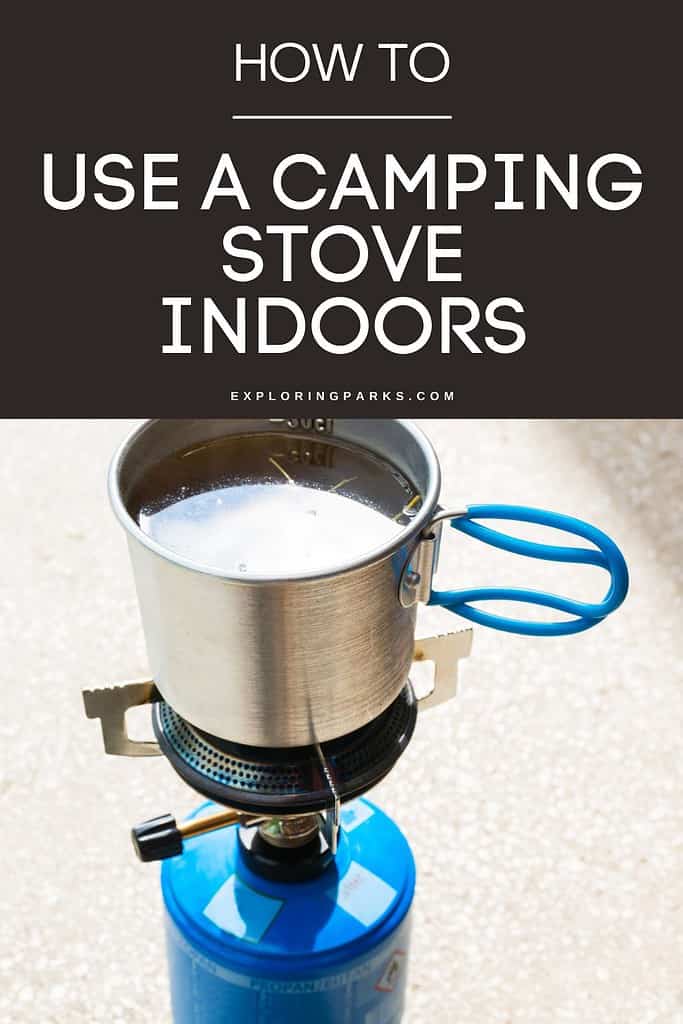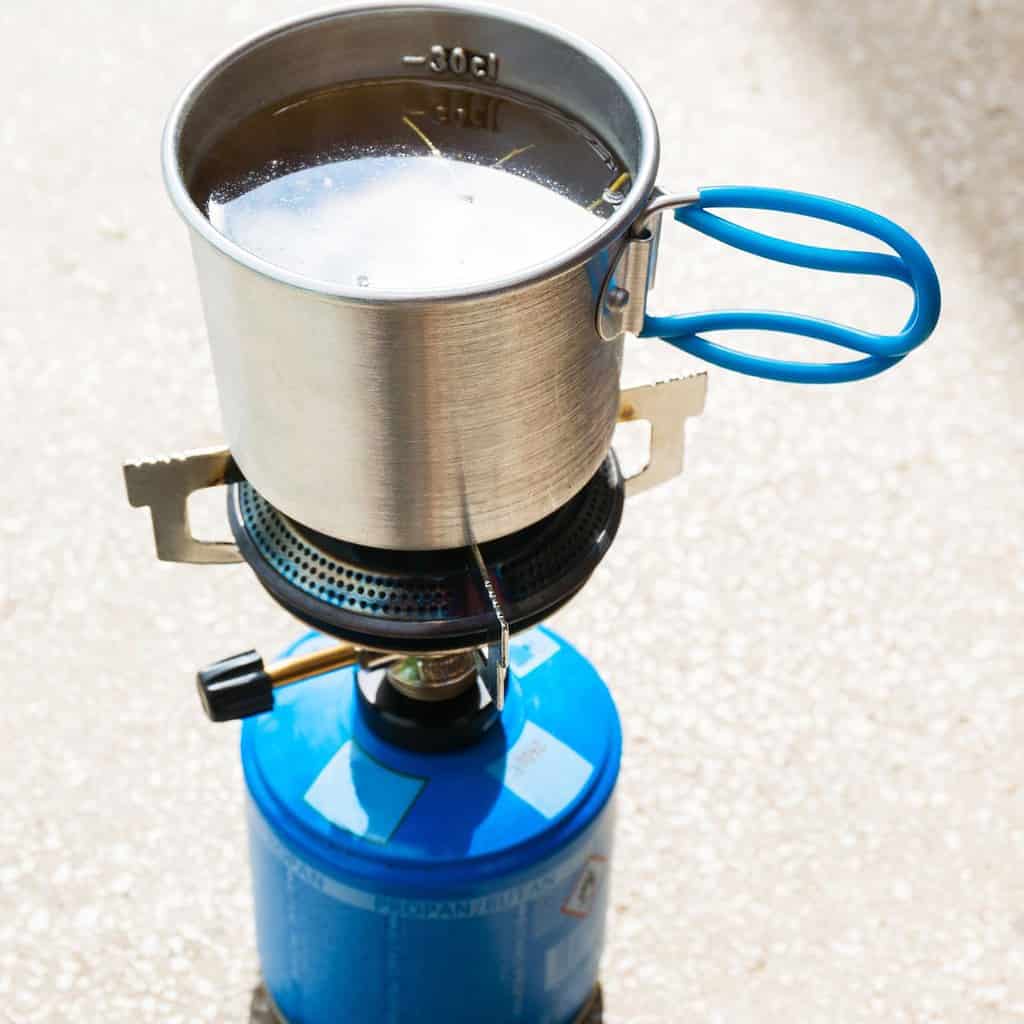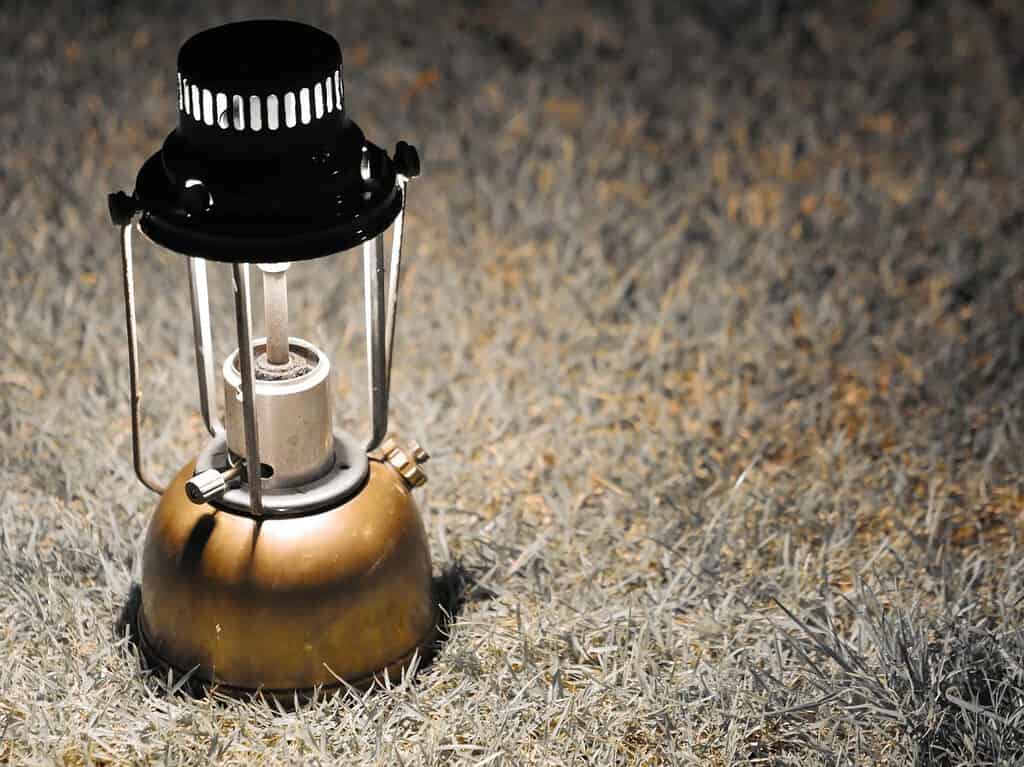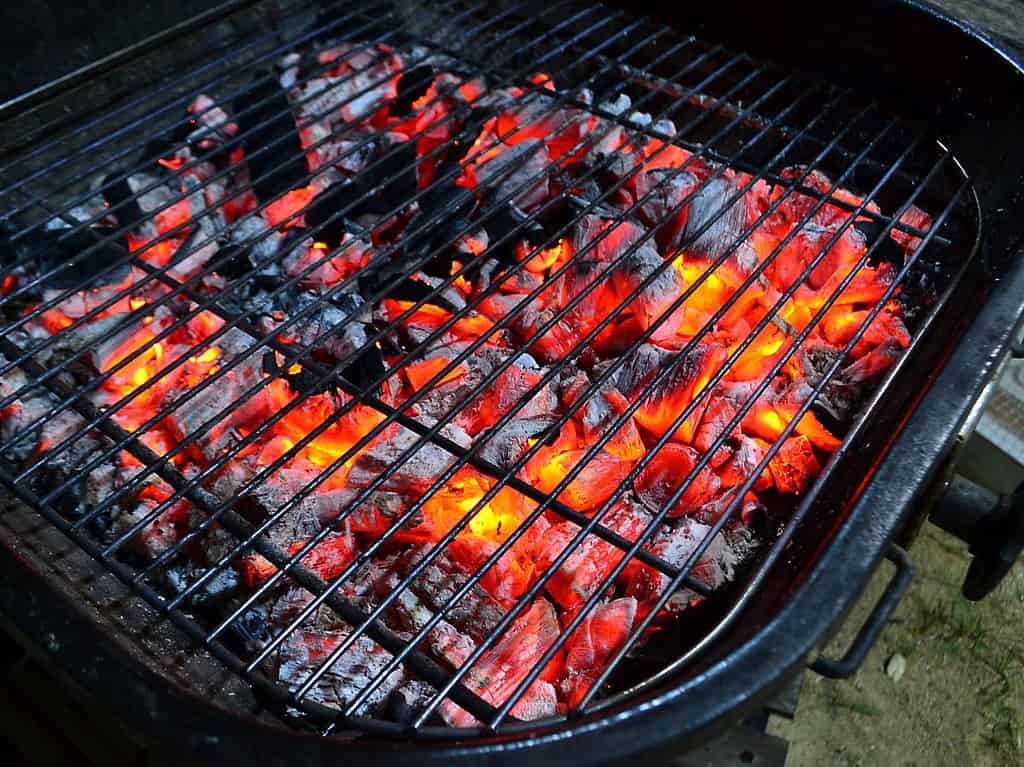How To Use A Camping Stove Indoors (Or In A Tent)
Natural gas stoves & propane gas ranges are commonly used inside a home’s kitchen, but can you use a camping stove indoors? What about in a tent? Let’s dive into the answers to these common questions.

This page contains affiliate links, which means I make a small commission at no extra cost to you. See full disclosure here.
Can I Use A Camping Stove Indoors?
In short, yes you can use a camping stove indoors if you take the proper safety measures. Camp stoves are designed for outdoor use, but there are steps you can take to safely use your camping stove indoors if needed.
Some of these safety measures are:
- Make sure there is proper ventilation
- Use clean burning fuels
- Monitor air with a carbon monoxide detector
- Have a fire extinguisher nearby
- Never leave stove unattended
*Always make sure to read the owner’s manual to your camping stove to ensure you can safely cook indoors with it*
Can I use A Camping Stove Inside A Tent?
The short answer is no, using a camping stove inside of a typical camping tent can be especially dangerous. If you find yourself in a situation where you’re on a camping trip and need to be out of the elements while you cook, then you should use your camping stove right outside your tent door under the rainfly.
Almost all tents are made out of highly flammable materials. One small spark to your fabric could ignite your entire tent within seconds while you are inside of it. Therefore, using your camping stove inside of your tent is not a good idea.
Unless you have an extra large hunting tent or hot tent where there is plenty of room to provide your stove with enough ventilation and not be near any fabric, then using your camping stove inside of a normal camping tent is not a safe idea.
Reasons it is not safe to use a camping stove inside of a tent:
- The fabric is highly flammable
- The enclosed space makes it easier for carbon monoxide to build up
- You don’t have enough time to escape if a fire starts
- You’re far away if you end up with severe burns and need medical attention
- The smells could attract a bear to your tent
The only way you might consider cooking inside your tent is:
- Your tent is floorless & you can cook a safe distance away from the walls
- Your tent is designed with a chimney for wood stoves
- You cook right outside your tent door in the fresh air & away from your tent fabric

The Risks of Using A Camp Stove Indoors
In general, the risks of using a camp stove indoors is starting a fire & carbon monoxide poisoning.
Most camp stoves are open flame stoves. This open flame can easily cause a fire, especially when used in an area with fabrics. The fire risk is one of the main reasons a camp stove is recommended to be used outdoors.
The risk of carbon monoxide poisoning is another issue when using a camp stove. When you’re indoors, you might not have adequate ventilation compared to when you’re cooking outside with a gas camping stove. Carbon monoxide is an odorless gas that is released from your stove that can cause you harm.

CO (carbon monoxide) can prevent your body from getting enough oxygen. It is hard to detect carbon monoxide without a monitor, therefore you might not realize you’re breathing in carbon monoxide until it’s too late.
The worst case scenario is that you could become faint and pass out while you’re cooking indoors. Then, you wouldn’t have a way to get to fresh air to ensure the poisoning doesn’t go any further.
These two risks can be very serious, so it is extremely important that you use the proper safety measures when using a camping stove indoors.
How To Safely Use A Camp Stove Indoors
Always read the instruction manual on your camping stove. Most camping stoves say they are for outdoor use only, and that is because of the two biggest risks when using a camping stove: starting a fire & carbon monoxide poisoning.
If you are in an emergency & need to use your camp stove indoors for survival, then make sure to follow these safety precautions:
- Use the proper type of stove fuel that is safe for indoor use (see below)
- Make sure your cooking area has adequate ventilation (like an open window)
- Use a carbon monoxide detector (CO detector) to ensure there’s no carbon monoxide build up while you’re cooking
- Have a fire extinguisher on hand just in case a fire starts
- Don’t allow pets or children around the camp stove
- Don’t cook near any fabrics, like curtains or towels
- Cook on a higher heat so the flame can burn away any carbon monoxide that is being let out. It’s not a good idea to let something “simmer” for long periods of time because the gas doesn’t burn away as quickly at a low heat.
- Don’t leave the camp stove unattended
- Let the camp stove completely cool before you store it away
- Make sure the pots & pans are not sitting directly on the flame, but have a rack holding them up above the flame. This will ensure the flame burns away the gas properly.
- Ensure the valves from your fuel source are properly tightened
- Always use common sense when cooking indoors

Types of Camping Stoves To Use Indoors
There are several types of camping stoves on the market. Some are more common than others, but let’s cover which are the most safe for indoor use.
| Safest To Use Indoors | Can Be Used Indoors | Should Not Be Used Indoors |
| Propane Stove Butane Stove Isobutane Propane (backpacking stove) | Alcohol Stove Kerosene Stove | Propane Grill Charcoal Grill Wood Stove (unless you have a proper chimney) |
Fuels That Are Safest To Use Indoors
From this list, the camping stoves that are the most safe to use indoors are propane stoves, butane stoves, & isobutane-propane stoves. Some of the other portable stove options might be used indoors in emergency situations, but these types of fuel are the cleanest burning.
Propane Stoves
Propane is one of the most common fuel types when it comes to camp stoves. The infamous Coleman camp stove is a propane stove.
Propane is a great fuel to use because it burns very clean, with less of a carbon footprint.
It’s also very versatile because of the different ways you can store propane. You could buy individual propane canisters or you could use a large propane tank that is refillable and will cost you less money in the long run (make sure you have a proper regulator hose if you go this route).
We personally use a 5-lb propane tank for our camping trips that fuels our camping stove and propane heater. We are able to fill it up for just a few dollars and it will last us for months of camping.

Butane Stoves
Butane is another fuel that burns clean and can be used indoors with proper precautions. This might be a better option for you because the stoves are compact and the canisters are slightly cheaper than propane.
The one downfall is that you won’t easily find refillable butane canisters, so you’re stuck using and throwing away canisters every time you camp.
Isobutane Propane Stoves
If you need something compact for cooking indoors, then isobutane propane fueled stoves are a good choice. These stoves are typically used by backpackers.
The fuel is clean & the canisters are lightweight. The most well-known stove that uses this type of fuel is the JetBoil. We love using the JetBoil for our morning coffee while camping because it’s so small and heats up quickly.

Other Fuels That Can Be Used Indoors
Alcohol stoves & kerosene stoves are other options than you might use indoors if you’re in an emergency. These types of fuels aren’t as safe, but with the proper precautions can be used in a pinch.
Alcohol Stoves
Alcohol is a less common fuel used for camping and outdoor cooking. Many people choose to use this type of fuel because it is easier to find when traveling to other countries.
The biggest danger with alcohol stoves is that if the liquid is spilled while lit, then a fire can spread very quickly. You have to be extra careful that the stove is on a sturdy surface and nobody is going to knock it over while cooking.
Kerosene Stoves
Kerosene used to be a common fuel to use for cooking and heating, and even in lanterns. Kerosene does not burn as cleanly as propane or butane.
Because it doesn’t burn as cleanly, it is more likely to cause carbon monoxide poisoning. Be extra careful that you’re in a properly ventilated area when using kerosene.

Fuels That Should Not Be Used Indoors
When it comes to cooking indoors, you should never use a charcoal grill, propane grill, or wood stove (unless you have a chimney).
Charcoal Grills
Charcoal, although delicious, is a very dirty burning fuel type. The thick smoke that comes off of charcoal should not be used indoors because there isn’t enough ventilation to clear out all of the smoke.

Propane Grills
Your typical backyard propane grill should not be used indoors. The amount of propane released from these types of grills is too much for indoor use.
Propane camping stoves have a regulator on them that only allow for small amounts of propane to be released at a time. The larger backyard grills are designed to be used in an outdoor space only.
Wood Stoves
You should never bring wood inside to cook on because the smoke will quickly fill up the space. The only time you can use a wood stove indoors is if you have a proper chimney installed for the smoke to be ventilated outside the home.

Conclusion
With the proper precautions, you can use a camping stove indoors. They can be a great option during a natural disaster in which you lose power. Although you can use camping stoves indoors, you should never use you camp stove inside of a typical camping tent because the risk of fire is too high.
*This post is for educational purposes only. Always read through the manufacturer’s guide before attempting to cook with your camping stove.*
Our Favorite Must-Have Camping Gear
Gazelle T4
Hub Tent

Jackery Solar
Generator

Qomotop Self-Inflating Mattress

THERMACELL MOSQUITO REPELLER

Related Posts
How To Cook While Camping
Best Canned Foods & Non-Perishables For Camping
Camping Kitchen Essentials Checklist
Car Camping vs. Backpacking (Which Is For You?)
How To Stay Warm In A Sleeping Bag
What To Pack For Camping With Dog Checklist
How Much Does Camping Cost? (Average Budget)
How To Choose Hammock vs. Tent Camping
Basic Camping Packing List

If this is your first time camping, or you need a refresh, then here is a free download for our Basic Camping Packing List. It is a full list of the basic items you need to bring for a successful camping trip.
